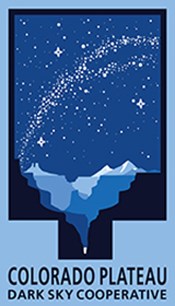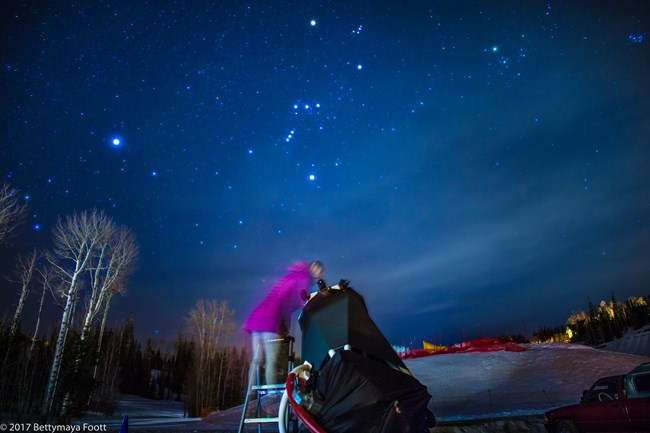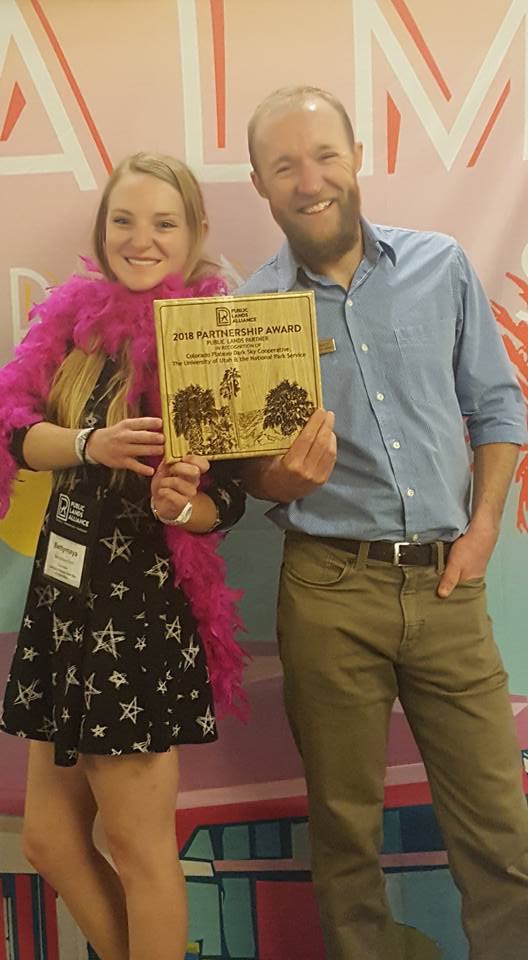Last updated: April 6, 2021
Article
Partnerships Expand Protection

Bettymaya Foott / NPS

Logo courtesy of the Colorado Plateau Dark Sky Cooperative.
National Park Service partners come in all shapes and sizes, from research universities to large businesses to community organizations. Partnerships extend the work of NPS to wider audiences and areas beyond protected park borders. In the case of one partner, the Colorado Plateau Dark Sky Cooperative, this work applies to the night sky itself.
The night sky is a defining feature of the Colorado Plateau—high desert country spanning 130,000 square miles across the Four Corners region of Arizona, Colorado, New Mexico and Utah. In this sparsely populated area, few cities are present to project urban light domes. For much of the plateau, the Milky Way and other celestial features stand out in startling clarity. The Colorado Plateau Dark Sky Cooperative is a multi-agency effort involving the NPS and other partners working to keep the nighttime qualities of the region intact. A night sky free of light pollution is important for wildlife and ecosystem functions, and it provides stellar viewing experiences for residents and tourists alike.
Twenty-seven national parks are located within the Colorado Plateau. The National Park Service Natural Sounds and Night Skies Division monitors nighttime conditions in parks and provides guidance to park staff for improving outdoor lighting. The cooperative extends this work by raising regional and community awareness about night sky issues and encouraging sustainable lighting choices to reduce light pollution. Its projects engage parks, visitors, residents, schools, businesses, and many organizations across the Four Corners. At the center of its outreach program is dark sky coordinator Bettymaya Foott.

Photo courtesy of Bettymaya Foott / NPS
As a child growing up in Moab, UT, Foott was no stranger to the wonders of the night in the red-rock desert environment she called home. Moab is located in the heart of the Colorado Plateau near Arches National Park. From stargazing on the backyard trampoline to sleeping under the stars on camping trips, her love for the night sky deepened through the years. In college at the University of Utah in Salt Lake City, she integrated this passion into her environmental and sustainability studies, writing a thesis paper, “Light Pollution Hazards Within Ecosystems and Mitigation Strategies for the Future.” Given her vested passion in the subject, the job of coordinator for the cooperative seemed a natural fit.
Foott’s work to date has focused on municipal education and outreach in communities located near or adjacent to national parks. Outdoor lighting in these communities can affect night sky conditions in parks as well as the greater region.
“Gateway communities to national parks play an important role in keeping the night dark,” Foott said. “It’s been exciting to see very separate and unique organizations coming together around this common cause.”
Outreach projects include developing curricular materials for K-12 students, training classes for city planners, workshops for park interpreters, and stargazing programs for residents and tourists. One popular program she would love to see continue is the Utah Symphony Great American Road Trip, a biennial event where concertgoers experience symphonic works in some of Utah’s most stunning natural settings. The 2017 tour featured performances in accredited or aspiring international dark sky parks, and hosted star parties and educational booths during and after the concerts.
“I want people to experience the wonders of the night sky that I saw as a kid,” Foott said. “To do this, I’m building a community of stakeholders using a ‘teach the teachers’ model of helping people within the region do the work, who can then carry the work forward—for the Colorado Plateau and beyond.”
Community support is not a given, she said, but a slow and steady process toward collaboration. Creating dialogue for both skeptics and enthusiasts to have a voice at the table is integral to the cooperative’s approach, and usually makes for win-win outcomes. Foott said that framing night sky goals as a rural and economic development issue helps residents relate.
“Astro-tourism benefits gateway communities,” she said. “Tourists who visit national parks in the Colorado Plateau, like Arches or Canyonlands, for example, often also want to experience the area’s dark, night sky views. They stay in nearby towns to attend night sky programs offered by parks and community astronomy groups. Money spent at hotels, restaurants, and other services boosts local economies.”
In order to attract and sustain astro-tourism, many gateway communities have made simple yet effective improvements to reduce light pollution. One change recommended by the cooperative is to replace outdoor light fixtures where needed with those that shield and direct light down to the ground instead of up into the night sky, where it is wasted and contributes to glare or sky glow. Using sustainable bulbs in the warm-white or amber spectra instead of the bright blue-white color range is another recommendation that Foott said makes a big difference. Each community determines a plan of action that works best for it. Some Utah towns such as Torrey, Ogden Valley, and Springdale have gone the distance by creating lighting ordinances. Utah has the most dark sky parks in the world—areas with exceptional night sky conditions and lighting standards that help keep them that way.
“Outdoor lighting improvements bring immediate, recognizable results for reducing light pollution and enhancing night sky views,” Foott said. “It can be as easy as flipping off a switch. Once residents realize how transformative, cost-effective, and relatively easy it is to make these changes, they are excited to participate.”

Photo courtesy Bettymaya Foott and the Colorado Plateau Dark Sky Cooperative

Photo courtesy of Bettymaya Foott and the Colorado Plateau Dark Sky Cooperative.
Municipalities within the Colorado Plateau that have implemented lighting changes have seen a difference. Others are noticing, too. In March 2018, the Public Lands Alliance recognized the achievements of the Colorado Plateau Dark Sky Cooperative and two of its partners, the University of Utah and National Park Service, with a Public Lands Partner Award. (Read the press release.)
The award honors a partnership that demonstrates excellence in protecting public lands and enriching visitor experiences. It reflects both the work of Foott and that of the cooperative’s former coordinator, Nate Ament, an NPS employee who served the group from 2013 to 2016. Ament was recognized in 2017 with an award by the International Dark Sky Association, another partner to the cooperative and worldwide leader in reducing light pollution.
Foott said that the award gives positive feedback for the work of the cooperative and the National Park Service and that the conference introduced her to new peers with whom to explore future collaborations.
Randy Stanley, night skies coordinator for the NPS Intermountain Region Office in Colorado, has supported the cooperative and worked on night skies projects with both Foott and Ament.
“The enthusiasm and dedication of individuals like Bettymaya and Nate is what makes these partnerships successful,” Stanley said. “Their efforts have increased local awareness and focus on the night sky resource within the plateau. Since the cooperative was initiated in 2013 by the National Park Service, it has seen many accomplishments.”
Looking ahead, one project in development that Foott and Stanley are excited about is the Skyglow Estimation Toolbox. This software program by NASA-DEVELOP and NPS scientists models skyglow, or light pollution. The toolbox uses satellite data to reveal light from multiple angles and directions for any given area and shows the effect as if seen by an observer on the ground. The data give accurate information about night sky conditions for areas within the Colorado Plateau that city planners and park managers can use for developing outdoor lighting action plans.
Whatever the nature of the project, the Colorado Plateau Dark Sky Cooperative is cultivating a night skies network that Foott hopes will extend the goals of the cooperative and National Park Service for years to come.
Article by Julie West, communications specialist, National Park Service Natural Sounds and Night Skies Division.

Bettymaya Foott / NPS
References:
- Colorado Plateau Dark Sky Cooperative: https://cpdarkskies.org/
- The Natural Sounds and Night Skies Division collects data on night sky conditions in parks, and recommends sustainable lighting solutions to eliminate unneeded light. Learn more: https://www.nps.gov/subjects/nightskies/index.htm
- International Dark Sky Association: http://www.darksky.org/
- Public Lands Alliance: http://publiclandsalliance.org/home
- NASA-DEVELOP Skyglow Estimation Toolbox: https://develop.larc.nasa.gov/2017/fall/ColoradoPlateauUD.html
- Colorado Plateau Urban Development Team Video: https://www.youtube.com/watch?v=m0heqJh00BE
Tags
- night skies
- natural sounds and night skies division
- colorado plateau dark sky cooperative
- bettymaya foott
- find your park
- find your park after dark
- finding your park after dark
- night sky
- night skies management
- partnerships
- partners
- science of the american southwest
- four corners
- american southwest
- southwest
- national park service
- nps
- scenic views
- design and construction
